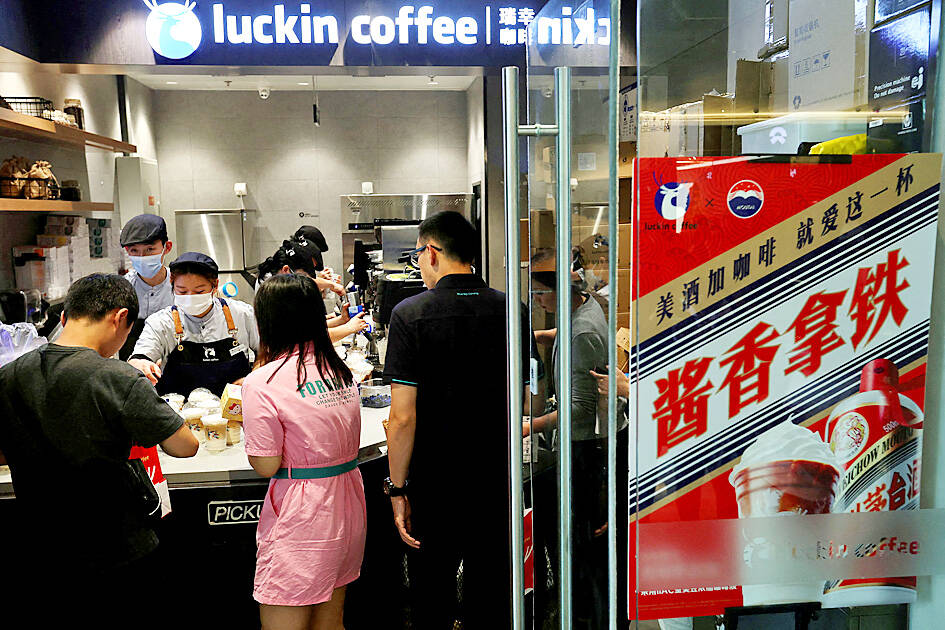Alcohol-infused chocolate balls are the latest item to take over China’s social media as consumers clamor for the surprise tie-up between liquor giant Kweichow Moutai Co (貴州茅台) and Mars Inc’s Dove brand.
The chocolates, which sell for 35 yuan (US$4.80) for two 10 gram pieces, sold out immediately when launched on Saturday and presales every day since are also sellouts. Despite some social media complaints about the high price, the chocolates are also proving popular on resale platforms, where 12 chocolates are selling for 500 yuan, according to local media reports.
The partnership follows Luckin Coffee Inc’s (瑞幸咖啡) popular launch earlier this month of an alcohol-infused latte, with Kweichow Moutai wanting to appeal to a younger demographic.

Photo: Reuters
The firm gets more than 80 percent of its revenue from moutai, a colorless but fiery liquor traditionally served at state banquets and popular among middle-aged consumers.
“As a traditional Chinese brand, Moutai needs to be forever young and embrace the young generation to enhance vitality,” chairman Ding Xiongjun (丁雄軍) said on Saturday.
Market watchers are split about the recent tie-ups translating into better sales over the long term. Bloomberg Intelligence has said it affirms the view that the distiller might continue with its accelerated efforts to rejuvenate the brand.
Others have warned that the low-cost items’ popularity may tarnish its luxury image.
“Marketing campaigns that link a premium brand like Moutai to too many mass-market consumption may not be helpful,” said Zhao Huanyan (趙煥焱), a Shanghai-based economist at Huamei Consulting Co (華美顧問).
The liquor firm has already sought to clarify its priorities, vowing to stick to its core business.
The collaboration is “trying to enhance Moutai’s competitiveness,” Ding said. “No matter how the time changes and how consumption is upgrading, Moutai started with liquor and will focus on liquor.”

The US dollar was trading at NT$29.7 at 10am today on the Taipei Foreign Exchange, as the New Taiwan dollar gained NT$1.364 from the previous close last week. The NT dollar continued to rise today, after surging 3.07 percent on Friday. After opening at NT$30.91, the NT dollar gained more than NT$1 in just 15 minutes, briefly passing the NT$30 mark. Before the US Department of the Treasury's semi-annual currency report came out, expectations that the NT dollar would keep rising were already building. The NT dollar on Friday closed at NT$31.064, up by NT$0.953 — a 3.07 percent single-day gain. Today,

‘SHORT TERM’: The local currency would likely remain strong in the near term, driven by anticipated US trade pressure, capital inflows and expectations of a US Fed rate cut The US dollar is expected to fall below NT$30 in the near term, as traders anticipate increased pressure from Washington for Taiwan to allow the New Taiwan dollar to appreciate, Cathay United Bank (國泰世華銀行) chief economist Lin Chi-chao (林啟超) said. Following a sharp drop in the greenback against the NT dollar on Friday, Lin told the Central News Agency that the local currency is likely to remain strong in the short term, driven in part by market psychology surrounding anticipated US policy pressure. On Friday, the US dollar fell NT$0.953, or 3.07 percent, closing at NT$31.064 — its lowest level since Jan.

The New Taiwan dollar and Taiwanese stocks surged on signs that trade tensions between the world’s top two economies might start easing and as US tech earnings boosted the outlook of the nation’s semiconductor exports. The NT dollar strengthened as much as 3.8 percent versus the US dollar to 30.815, the biggest intraday gain since January 2011, closing at NT$31.064. The benchmark TAIEX jumped 2.73 percent to outperform the region’s equity gauges. Outlook for global trade improved after China said it is assessing possible trade talks with the US, providing a boost for the nation’s currency and shares. As the NT dollar

The Financial Supervisory Commission (FSC) yesterday met with some of the nation’s largest insurance companies as a skyrocketing New Taiwan dollar piles pressure on their hundreds of billions of dollars in US bond investments. The commission has asked some life insurance firms, among the biggest Asian holders of US debt, to discuss how the rapidly strengthening NT dollar has impacted their operations, people familiar with the matter said. The meeting took place as the NT dollar jumped as much as 5 percent yesterday, its biggest intraday gain in more than three decades. The local currency surged as exporters rushed to